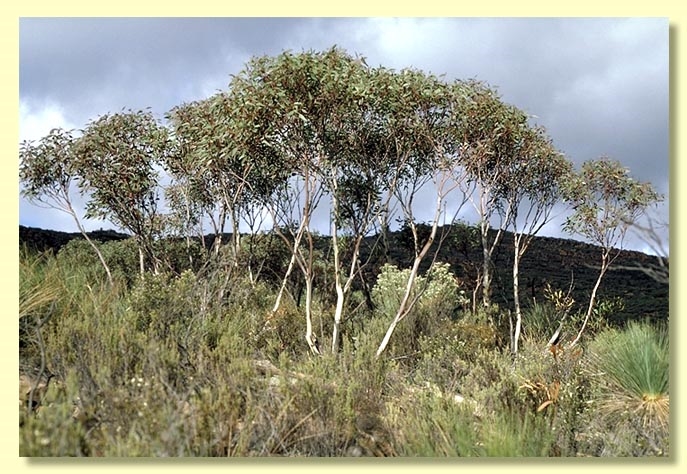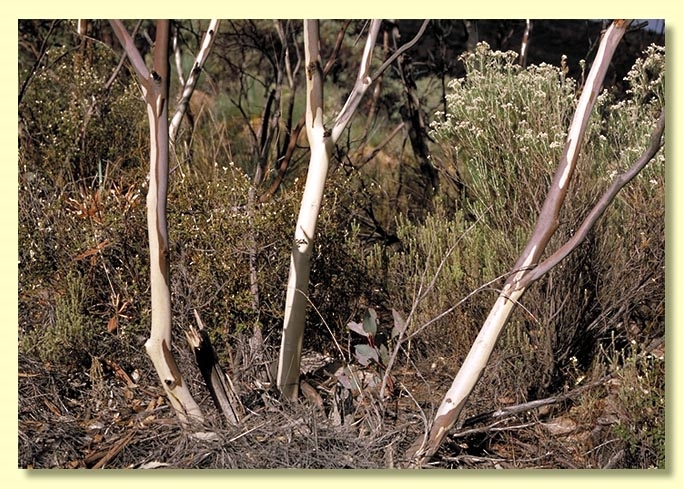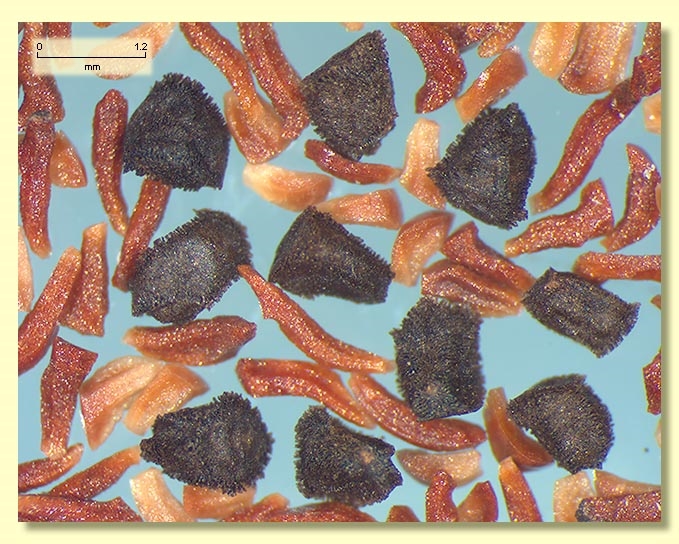Euclid - Online edition
Eucalyptus flindersii
Eucalyptus | Symphyomyrtus | Exsertaria | Erythroxylon
T: Mt Hack, S.A., 10 Sept. 1969, R.Callen 38; holo: AD.
Bark usually smooth, pinkish grey over white, cream or grey, but sometimes partly rough and loose or box-like and grey.
Juvenile stem square in cross-section, sometimes slightly winged; juvenile leaves always petiolate, opposite for 5 to 8 nodes then alternate, broadly ovate to ovate, 4.5–11 cm long, 2.5–7 cm wide, base tapering to petiole, dull, green to grey-green.
Adult leaves alternate, petiole 1–3.8 cm long; blade narrowly lanceolate to lanceolate or falcate, 5.5–18 cm long, 1–3 cm wide, base tapering to petiole, concolorous, slightly glossy or dull, yellow-green or grey-green, side-veins at an acute or wider angle to midrib, moderately to densely reticulate, intramarginal vein parallel to and well removed from margin, oil glands island.
Inflorescence axillary unbranched, peduncles 0.4–1.8 cm long, buds 3 or 7 per umbel, sessile to shortly pedicellate (pedicels 0–0.5 cm long). Mature buds ovoid (0.7–1.3 cm long, 0.4–0.6 cm wide), green to yellow, scar present (outer operculum falling early), operculum rounded to conical (0.4–0.7 cm long), stamens variously flexed (some outer erect, inner inflexed or irregularly flexed), anthers cuboid to oblong, versatile, dorsifixed, dehiscing by longitudinal slits (non-confluent), style long, stigma blunt, locules 3 or 4, the placentae each with 6 vertical ovule rows. Flowers white.
Fruit sessile or shortly pedicellate (pedicels 0–0.3 cm long), hemispherical to obconical, 0.3–0.7 cm long, 0.4–1 cm wide, disc raised-convex or -oblique, or disc level, valves 3 or 4, exserted.
Seeds black, 0.9–1.5 mm long, cuboid or pyramidal, dorsal surface usually pitted, hilum terminal.
Cultivated seedling (scored at ca node 10): cotyledons more or less oblong-reniform; stems square in cross-section; leaves always petiolate, opposite for 6 or 7 nodes then alternate, deltoid to ovate, 7–16 cm long, 3.5–13.5 cm wide, dull, green to blue-green.
Flowering has been recorded in August, September and October.
A mallee or rarely small tree endemic to South Australia, occurring mainly on slopes and summits of peaks in the Northern Flinders Range, also Devil's Peak south-west of Quorn and Pualco Hill south of Yunta. E. flindersii usually has smooth bark, rarely rough on the trunk, e.g. at Yourambulla Hill south of Hawker. The leaves are slightly glossy, yellow-green or grey-green and the buds commonly in groups of three.
Eucalyptus flindersii belongs to the group of red gums which is distinguished by having buds with the stamens mostly erect, fruit where the disc is united to the ovary roof and by the black, toothed, cuboid to pyramidal single-coated seed. Fourteen species belong to this group: E. amplifolia, E. blakelyi, E. chloroclada, E. dealbata, E. dwyeri, E. flindersii, E. gillenii, E. glaucina, E. infera, E. kabiana, E. nandewarica, E. tereticornis, E. terrica and E. vicina.
Eucalyptus flindersii is most closely related to E. gillenii, which is distributed on rocky ranges of central Australia. E. flindersii has fruit with a flatter disc (disc raised in E. gillenii), buds in clusters of three or seven (usually seven in E. gillenii), seedlings with deltoid to ovate leaves (lanceolate in E. gillenii) and sometimes has a partly rough-barked trunk (always smooth in E. gillenii). E. nudicaulis from the Mt Isa region of north-western Queensland is also closely related to E. flindersii. It differs by having narrowly lanceolate juvenile leaves.
E. amplifolia from subcoastal and tableland areas of New South Wales and south-east Queensland and E. tereticornis, a common tree in eastern Australia from Bega to the top of Cape York Peninsula, and E. glaucina from the low coastal ranges and tablelands of central-northern New South Wales differ by having large ovate to orbicular to deltoid juvenile leaves. Juvenile leaves usually glossy in E. amplifolia and dull blue-green to green in E. tereticornis and dull blue-green to glaucous in E. glaucina. E. tereticornis can be further separated by having buds with a much longer narrower operculum than E. flindersii. E. kabiana , from Mt Beerwah in the Glasshouse Mountains, also differs by having buds with a longer narrow operculum like E. tereticornis. E. chloroclada, from the western slopes and plains of New South Wales, from the Pilliga area northwards into the Texas, Cracow, Tambo, Dirranbandi area of south-east Queensland and E. terrica, from the Inglewood and Warwick region of south-east Queensland, differ by normally having lots of rough bark on their trunk. E. infera, an odd eucalypt from the Warwick region in Queensland, has typical red gum buds and fruit but has juvenile leaves similar to the swamp gum E. camphora that are ovate to orbicular, with an emarginate apex and margins often with shallow crenulations.
E. blakelyi from Victoria, where it occurs mainly north of the Great Dividing Range, through the tablelands of New South Wales to far south-eastern Queensland, differs by having buds with a long narrow acute operculum. (The buds of E. flindersii are normally broad and the operculum rounded to bluntly acute.) On stony sites in far western New South Wales, north and west of the Lachlan River west almost to the River Darling is E. vicina. It differs from E. flindersii by having juveniles with glaucous stems and smaller leaves. E. dealbata from the slopes and tablelands mostly west of the Dividing Range in central and northern New South Wales from about Grenfell and Cowra northwards, extending into the Stanthorpe, Warwick, Leyburn, Inglewood, Texas region of south-east Queensland, differs by having very glaucous buds and fruit and juveniles. E. dwyeri, of elevated sandstone areas of the upper Hunter Valley (e.g. Denman to Gungal) and the central western slopes and southern part of the north-western slopes of New South Wales, west to near Lake Cargelligo and south-west to Griffith and Narrandera, and E. nandewarica, from an enclave in foothills near Kaputar north-east of Coonabarabran, differ from E. flindersii by having narrowly lanceolate to lanceolate juvenile leaves and by having smaller buds and fruit.
E. flindersii has sometimes been confused with another three-budded mallee red gum, E. morrisii. E. morrisii is scattered on rocky hills east of the Darling River in the Bourke–Cobar–Nyngan–Yathong area of north-western New South Wales. It belongs to another series in Section Exsertaria, i.e series Phaeoxylon, where all the members of this group have thick rough bark over most of the trunk. E. flindersii is predominantly smooth-barked, with some larger individuals with rough accumulated bark at their base.
Within its natural range E. flindersii is unlikely to be confused with any other species because of its mallee habit and hemispherical fruit with prominently exserted valves.
MORE ABOUT RED GUMS AND OTHER ASSOCIATED GROUPS














